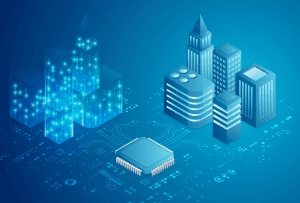
Combining real-time digital twins with in-memory computing can enable complex, live systems that quickly analyze telemetry and identify emerging issues requiring immediate responses.
Digital twins are typically used to create virtual representations of physical objects. They can correspond to a single element in a complex system, such as an aircraft engine, or to the entire system. However, they also can be used to track the dynamic state of physical systems or devices (e.g., IoT devices, equipment on an assembly line, a smart building, etc.) that generate telemetry. Such digital twins are considered real-time digital twins.
Streaming data makes the difference
The distinction between a traditional digital twin and a real-time digital twin is how they make use of streaming telemetry data.
![Sponsored Resource: Enhancing Intelligent Real-Time Monitoring with Streaming Analytics Using Real-Time Digital Twins [Download Now]](https://no-cache.hubspot.com/cta/default/8019034/68465e27-def5-49e0-953f-88df4c33b69c.png)
A common use of conventional digital twins is for product life cycle management (PLM). A PLM twin models a physical device’s behavior. For example, an equipment manufacturer might have a digital twin of a product used in an industrial assembly line. Telemetry collected from the device might be analyzed after the fact to understand its behavior. For instance, an operating temperature increase might be correlated to increased defects in the assembly line’s output. Or running the unit at a higher output level than the product is designed for might produce no problems.
In either case, the telemetry data is stored and analyzed at a later date. Discoveries and inferences derived from that analysis can be used to refine and evaluate a device’s design. In a simple case, if a unit is consistently running hot, the equipment might need to be redesigned with more airflow or run at a lower speed.
The insights might also be used to implement simulations. If the operating speed is increased by X percent, what is the corresponding tradeoff between increased output and output quality degradation?
In contrast, real-time digital twins do the analysis on that streaming telemetry data as it is flowing in. Specifically, real-time digital twins track relevant, dynamic state information about a physical device to assist in streaming analysis. They are well suited for use in live applications to identify emerging issues and enhance situational awareness.
Information derived from a real-time digital twin can be used to take action immediately. A production line might be shut down rather than running a piece of equipment that produces an inferior final product. Or a part in a jet aircraft engine that is showing signs of problems might be replaced before the time specified by the manufacturer. Additionally, the information can be used to make adjustments on-the-fly to tweak operational efficiency.
Other examples include IoT devices in a power grid, water distribution network, security system, or vehicle fleet. Or a system may have many devices (i.e., a large vehicle fleet) that together generate large volumes of data that must be quickly analyzed to respond to emerging issues.
In all cases, the streaming data can be used in different ways, each of which requires increasingly more sophisticated analysis and more stringent time to insights. That might include using the data for:
- Asset monitoring where the data helps understand if the physical item is operating and how it is performing
- What-if analysis that allows companies to make adjustments and try different operational settings to optimize performance
- Predictive analytics, perhaps involving machine learning, to detect operational anomalies in real-time and initiate actions in real-time to prevent problems.
See also: ScaleOut Brings Real-Time Capabilities to Azure Digital Twins
Meeting the computational burden of real-time digital twins
One obstacle to real-time digital twins is that traditional analysis approaches have difficulty meeting their computational demands.
A common approach to using streaming data is to save it to a data lake or some other data store and then perform the analytics, usually employing big-data techniques. This approach increases latency and delays responses for issues that may be time-sensitive. So, if there is a failing refrigeration unit in a truck, the problem is detected after the fact, and the contents of the refrigerator are lost.
Additionally, this approach requires the design of a front-end system that queues messages and stages them for data storage. This can be challenging to implement for high message volumes.
In contrast, real-time digital twins can analyze streaming data on the fly. This approach enables faster responses. However, it requires a scalable software architecture for ingesting and analyzing incoming messages. Scalability becomes even more of an issue when many devices in a system all have digital twins.
One approach that addresses these issues is the use of in-memory computing (IMC). IMC hosts stage information in memory for fast access and updates. It can deliver messages to their respective digital twins in milliseconds for immediate analysis. And IMC can implement real-time data aggregation, via MapReduce, for example, in seconds to combine data from all digital twins and enable immediate visualization.
See also: Digital Twins Enable Real-Time Analytics at Scale
Benefits of using in-memory computing for real-time digital twins
In-memory computing for real-time analysis of streaming data is well-suited to the requirements of a digital twin model. It provides transparent scaling that handles high message volumes from a large collection of physical devices. It enables fast response times by avoiding message queuing to secondary storage and offline analysis. And it enhances situational awareness with integrated data aggregation and visualization.
Application areas for real-time digital twins using this technology include:
- Telematics: Real-time digital twins track every vehicle in a fleet to identify issues with the engine, cargo, driver, and performance to schedule.
- Power grid: Real-time digital twins track each node (e.g., transformer, power pole, controller) to detect issues, such as an impending failure that could cause a fire or outage.
- Security and safety: Real-time digital twins track entries/exits at key points in an infrastructure, such as a nuclear power plant, to detect unauthorized incursions and threats to employee safety.
The combination of the real-time digital twin model with the performance of in-memory computing promises to enable complex, live systems such as these that quickly analyze telemetry and identify emerging issues requiring immediate responses.
![Sponsored Resource: Enhancing Intelligent Real-Time Monitoring with Streaming Analytics Using Real-Time Digital Twins [Download Now]](https://no-cache.hubspot.com/cta/default/8019034/68465e27-def5-49e0-953f-88df4c33b69c.png)




























